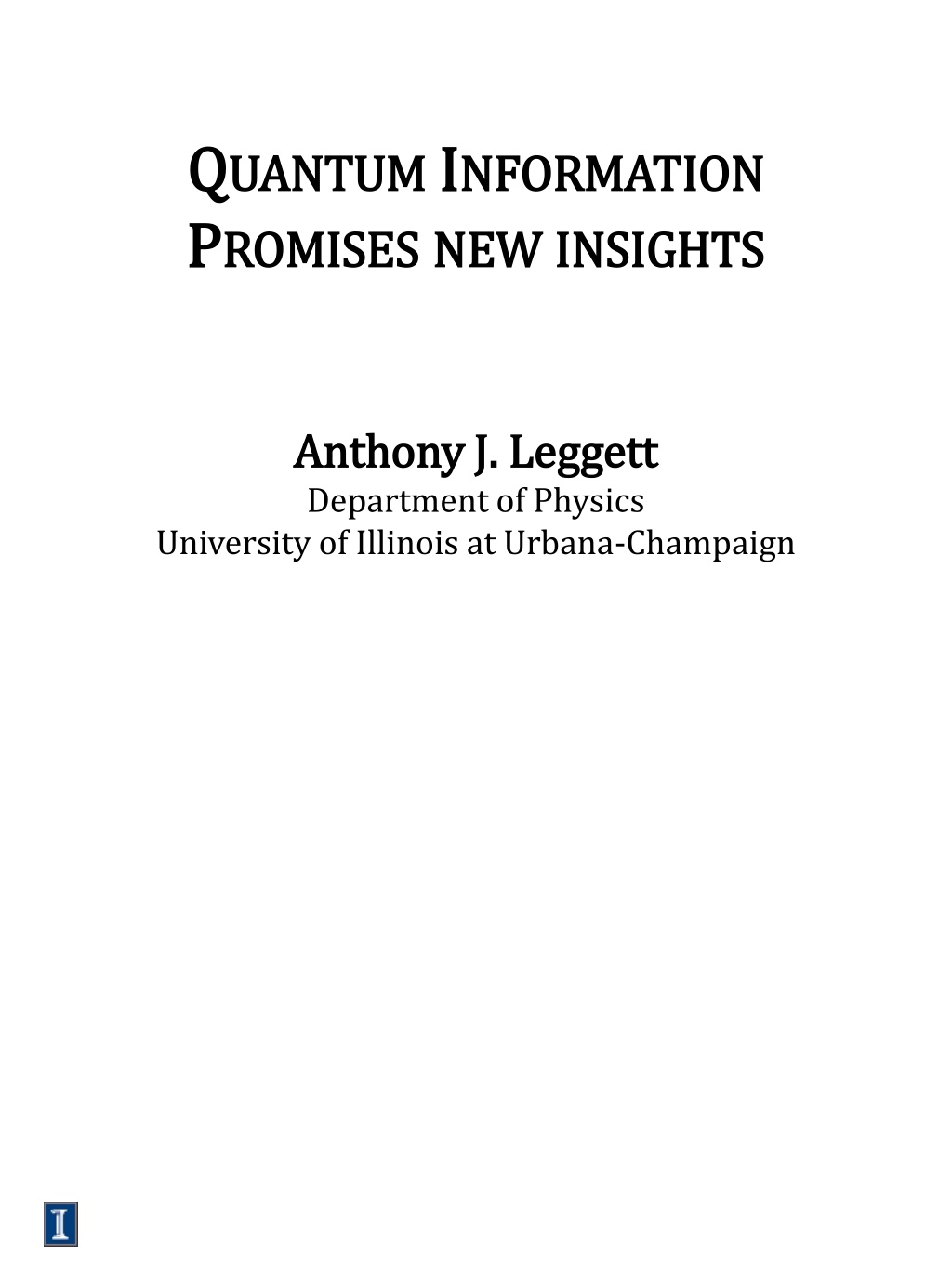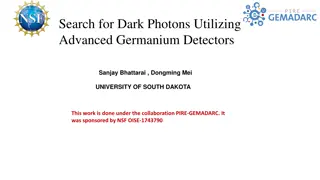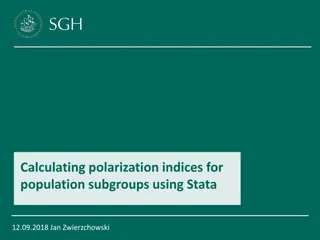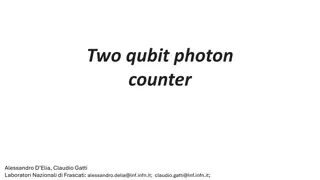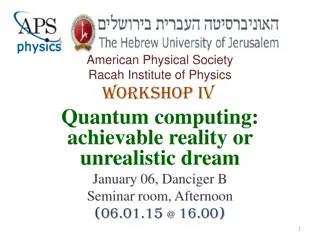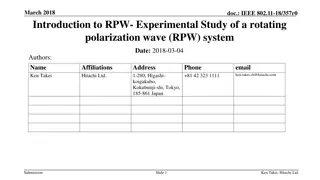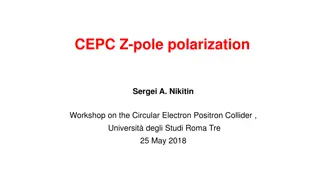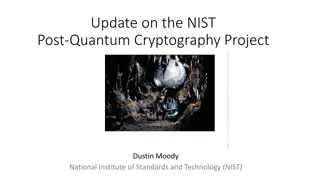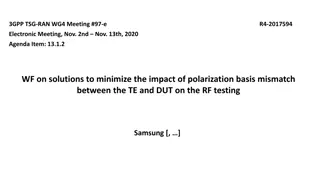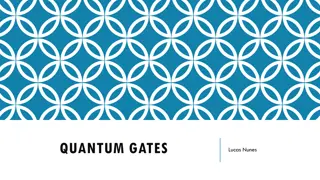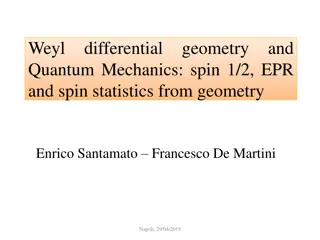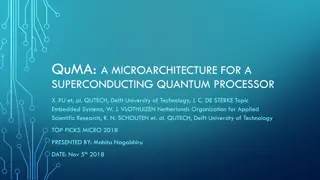Exploring Quantum Information through Polarization of Photons
Quantum information and photon polarization are explored in this detailed presentation featuring the ultimate quantum 2-state system. The content delves into the behavior of single photons at a quantum level, showcasing the intriguing properties and implications of quantum superposition in polarization experiments. Various polarization states, classical resolutions, and quantum outcomes are analyzed, providing insights into the fundamental principles governing photon behavior. The exploration culminates in a discussion on the uniqueness of quantum superposition and its distinctions from classical mixtures.
- Quantum Information
- Photon Polarization
- Quantum Superposition
- Photon Behavior
- Polarization Experiments
Download Presentation

Please find below an Image/Link to download the presentation.
The content on the website is provided AS IS for your information and personal use only. It may not be sold, licensed, or shared on other websites without obtaining consent from the author. Download presentation by click this link. If you encounter any issues during the download, it is possible that the publisher has removed the file from their server.
E N D
Presentation Transcript
Q QUANTUM UANTUM I INFORMATION NFORMATION P PROMISES ROMISESNEW NEWINSIGHTS INSIGHTS Anthony J. Leggett Anthony J. Leggett Department of Physics University of Illinois at Urbana-Champaign
LED 50.1 PHOTON POLARIZATION THE ULTIMATE QUANTUM 2-STATE SYSTEM Some possible polarization states of light (photons) propagating towards screen: | | | | |V |H | + | Polarizer: | D2 | unpolarized light (classical) V/H setting D2 | + | +/- setting
LED 50.2 What happens at quantum level? | click D1 single photon V/H setting | D2 click
LED 50.3 But what if | + D1 I0 V/H setting D2 ? Classically, resolve components: | + into |H and |V 1 E+= 2(EH+ EV) electric field EV is transmitted, EH is reflected, so I1= I2=1 2 Io (Malus s law) output of D1 output of D2
LED 50.4 But what happens at the quantum level? A single photon cannot be split! , so for each photon (experimentally observed) either D1clicks ( photon is or D2clicks ( photon is |V ) |H ) P1 = P2 = (quantum version of Malus s law) prob. of click in D1 prob. of click in D2 So: is each individual photon indeed either (ensemble is mixture of |V or |H ? |V and |H )
LED 50.5 Is the original |V and | +beam a mixture of |H ? (i.e. is each individual photon either |H ?) |V or If so: by symmetry |V D1 single photon D2 +/- setting P1 = P2 = output of D1 output of D2
LED 50.6 Similarly for But | + is mixture of |H . So P( |V) = P( |H) = . |V and |H , so P( |+) = i.e. | + D1 single photon +/- setting D2 P1 = P2 = in contradiction to experiment! Conclusion: | + is a quantum superposition of |V and |H , and this is not equivalent to a mixture: each | + photon is not either |V or superposition principle |H
LED 50.7 POLARIZATION OF PHOTON PAIRS parity O+ 1 spin 2 O+ For photon propagating into page, denote states of circular polarization by | | |R |L right-circularly polarized left-circularly polarized The conservation of total angular momentum is consistent with either |R1 R2 or |L1 L2 ( product states)
LED 50.8 But if we don t know (and can t find out!) which if these occurred, must describe polarization state of photons by quantum superposition: 1 R2+ ei |R1 |L1 L2) ?= 2( (actually, parity conservation ei = 1 so (not obvious!) can equally well write ?= is not equivalent to a classical mixture of |L1 L2! In fact, (Bell, 1964): 1 |V1V2)). This |R1 R2 and |H1 2( H2+ of time, then the experimental predictions of ? are inconsistent with the assignation of any properties (not just polarization) to the individual photons 1 and 2! (and subsequent experiment unambiguously favors predictions of ?). If we assume local causality and the standard arrow product states of more than one system. Quantum information exploits (inter alia) the bizarre properties of entangled states. ? is an entangled state a quantum superposition of
LED 50.9 ENTANGLEMENT AS A RESOURCE polarization) is uniquely specified by (<) 2 complex numbers (e.g. the amplitudes for and |V ). So if we have N 2-state systems in a product state, we need ~2N complex numbers. However, to specify a general entangled state of N systems we need not ~2N but 2N complex numbers! e.g. for N = 4, we need to specify separately amplitudes for The state of a 2-state system (e.g. photon |H ,|HHVV |HHHH ,|HHHV ,|HHVH (16 = 24 states in all). Thus, possibility of massively parallel processing ( quantum computing ) Alas, a snag: measurement will reveal only one of the 2N states we lose all information on the 2N 1 others.
LED 50.10 Solution (Deutsch 1984, Shor 1995): devise algorithm such that at end system is in just one of the 2N states, the particular one depending one the answer to our problem. numbers (Shor 1995). (For N binary digits, time taken by classical computer exponential in N, for quantum computer polynomial in N). Interesting primarily for application to (classical) cryptography. Application: prime-factoring of large computer: Systems: nuclear spins, trapped ions, superconducting devices Practical difficulties in building quantum ideal 2-state system scalability decoherence at present, not practically competitive with classical computing, but
LED 50.11 QUANTUM CRYPTOGRAPHY (Bennett + Brassard 1984, Ekert 1990) Key distribution problem : Info (code) B B A A E In classical (and quantum) cryptography, Alice and Bob can t prevent Eve from listening in. But can they tell whether she is listening in? In classical cryptography, no (as far as as known); Eve can intercept message and pass it on without detection. Quantum cryptography: exploits no-cloning theorem (direct consequence of superposition principle):/ it is impossible to build a device guaranteed to detect and pass on unaltered a photon of arbitrary (unknown) polarization./
LED 50.12 Protocol: |V | + |H | either or | . Bob also measures at random, 50% of the time with setting H/V, 50% with +/-. At end of (say) 10,000 runs, Alice and Bob compare notes (they can use a classical (insecure) phone line) on settings, throw away those runs for which they have used different settings and compare notes on the rest. A emits photons at random, 50% of the time |H or |V and 50% of the time either | + sent similarly for If Eve is not listening in, then whenever Alice |H ( |V ) Bob should detect | + ( | ). |H ( |V ): decide how to set her polarizer! But Eve does not know whether Alice emitted ( ( | + or | ). If Eve is listening in on each run, she has to |H or |V ) or rather
LED 50.13 QUANTUM CRYPTOGRAPHY (continued) Suppose e.g. she chooses a +/ setting. Then if Alice in fact emitted | + or it and pass it on undetected. But what if Alice emitted |H or |V ? Then she (Eve) has 50% chance if passing it on wrong, and Alice and Bob will fail to agree and thus detect her eavesdropping. | , she can measure
